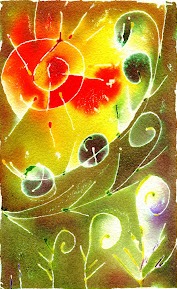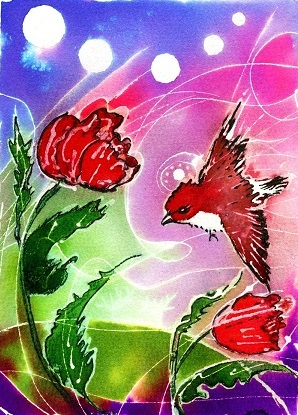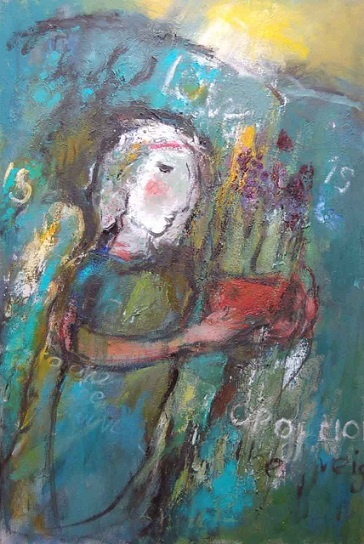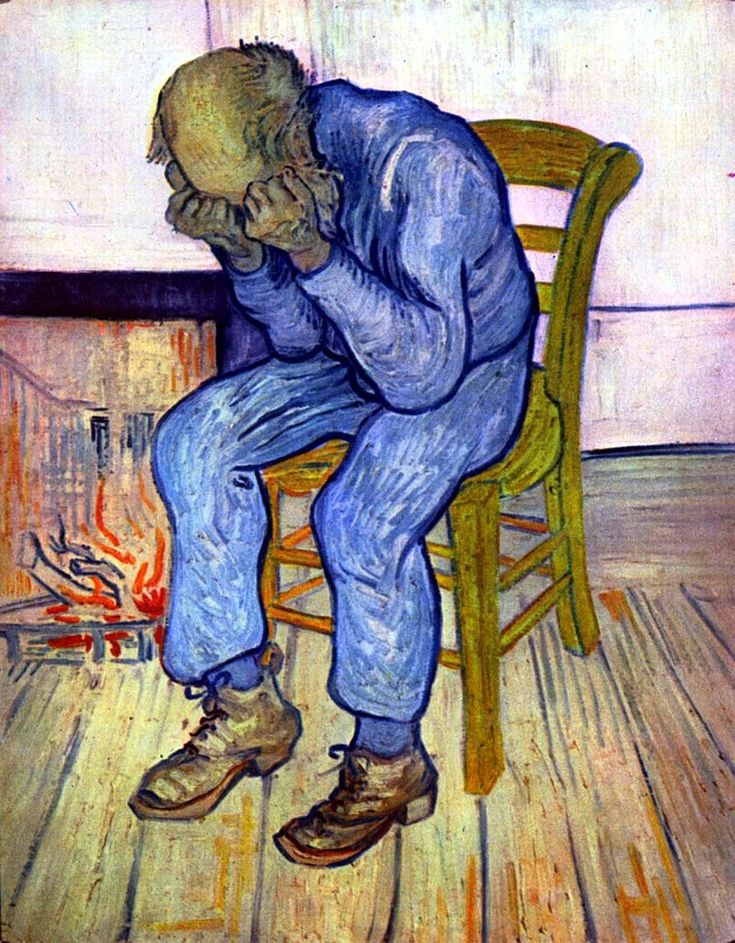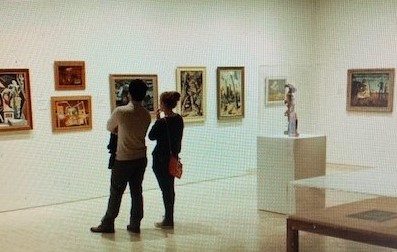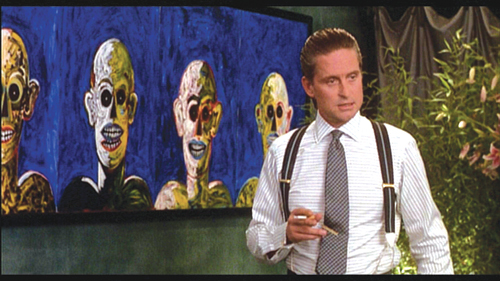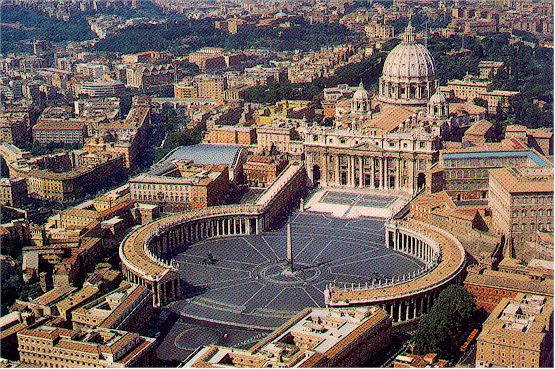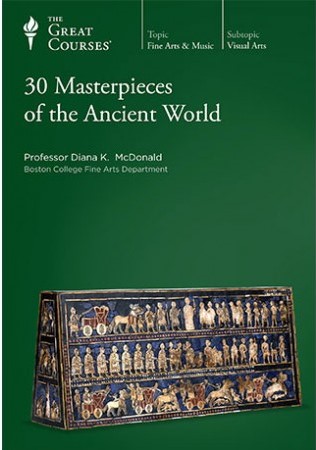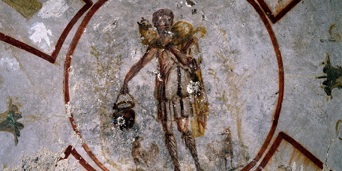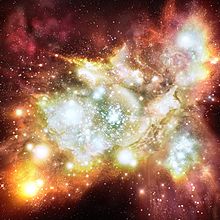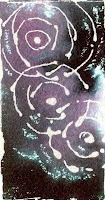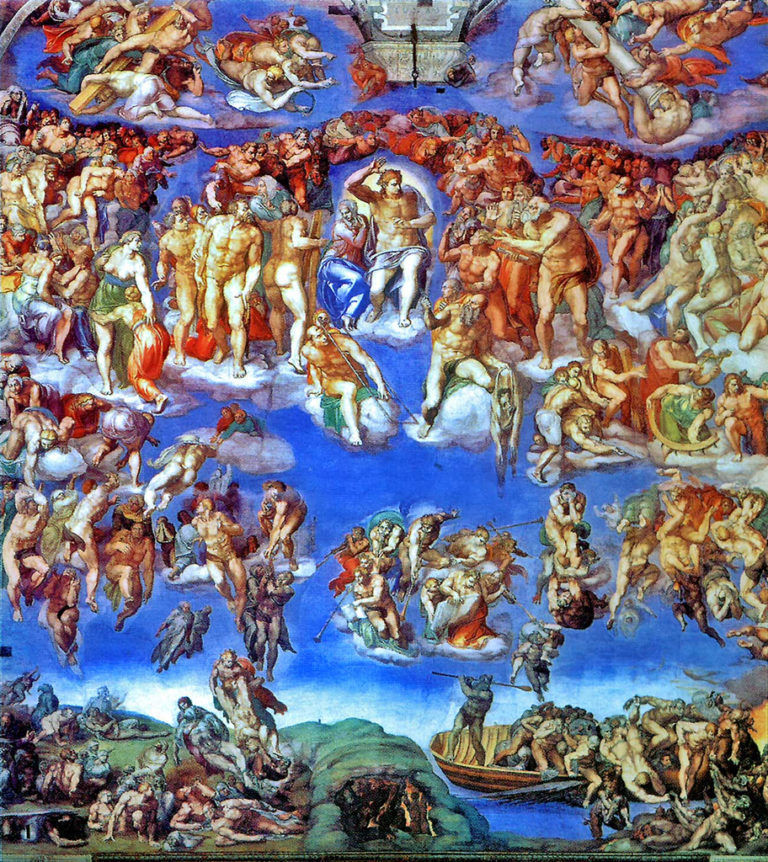|
home | what's new | other sites | contact | about |
|||||||||||||||||
|
Word Gems exploring self-realization, sacred personhood, and full humanity
Art
"To seek for the beautiful is its own reward." Nina Fawcett
Editor's Essay: Higher Creativity: Liberating The Unconscious For Breakthrough Insights Editor’s Essay: Weaponized Art: Part I: Art as Calculation to Overwhelm and Intimidate Editor’s Essay: Weaponized Art: Part II: 30 Masterpieces Of The Ancient World Mortimer Adler's Syntopicon Essay: Art Dr. Joseph Campbell: art and beauty as ‘aesthetic arrest’
Marc Chagall, Lovers With Half Moon
Benet Haughton, Angel Bearing Flowers, 2011 (Oil on canvas, 36” x 22”)
the beauty of the world, a streaming song, even as God’s ‘love letter’ to us Hina Khalid writes in Beshara Magazine, "Participating in the Divine Playfulness," exploring the theological aesthetics of Rabindranath Tagore: One of the most enchanting notes of the world’s polyphonic ‘love-call’ is that of beauty, which silently streams through the spring flowers and the serene night sky. Tagore presents worldly beauty as a constantly streaming song and even as God’s ‘love letter’ to us, which many of us have – unfortunately – not yet read. As a result, the blissful encounter of love to which we are called remains unrealised. God could have set forth a regal display of the divine power, Tagore writes, which would force us to turn to Him, but instead He seeks to gently woo us through the innumerable beauties of the world – the delicate dreaminess of dawn and the soft serenity of sunset. Indeed, God takes the ‘risk’ that these unfoldings of His beauty will be ignored by us and even that we will reject this beauty as ‘futile’. But still, He will not compel us in any way. 'this tender abundance,' this beauty born of a spirit of 'excess' Outlining this tender abundance, Tagore writes that whilst we must acknowledge and align ourselves with the fact that the sunrise heralds a new day – and pursue our daily work accordingly – we are not under any compulsion to discern the dawn as ‘beautiful and supremely peaceful’. Our loving attentiveness to its beauty is thus entirely free, but this [this free-spirited non-compulsory acknowledgement of underlying and sometimes-subtle beauty in the world] is itself a freedom to which we are, in a higher sense, bound [bound or intimately aligned with, in that we ourselves are expressions of God's delight to freely create beauty; a beauty which is non-utilitarian in nature, for God did not create us as private advantage to Herself] – for it is only in our free submission to beauty’s call that we inhabit the infinite truth of human life and come to know that this existence is, in fact, ‘a birth of joy’. One type of loving response to this divine call of beauty is crystallised for Tagore in the vocation of the artist. Tagore presents art as a joyful meeting of the divine and the human, which recapitulates in and through time the love-infused lila of the primordial divine artist. Like God’s cosmic lila [playfulness], art has its origins in the realm of ‘excess’, because we create art not as a means to an end but for freely delighting in the beauty of the world. In other words, when we renounce utilitarian or instrumentalist imperatives... [instrumentalism: the variety of pragmatism developed by John Dewey, maintaining that the truth of an idea is determined by its success in the active solution of a problem and that the value of ideas is determined by their function in human experience] ... in and through artistic creation, revealing the ‘wealth’ of our inner life, we reflect the God who ‘takes joy in productions that are unnecessary to him’. The artist offers herself and her art to God in perpetual iterations of re-turning, and utters in response to the world’s call... Endowed with this vision into the plenitude of finite reality, the artist sees more truly, and this is, in short, because she sees with the illuminative lens of love. To see through love is not to veer away from truth but to enter more fully into it, for love, in the worldviews of both Tagore and Pieper, is not a fleeting sentiment or subjective fancy but constitutes the ontological heartbeat of all created reality. As Tagore affirms, love ‘radiantly reveals the reality of its objects’, and, in Pieper’s formulation, the contemplative gaze is only truly itself when it is ‘guided by love… for a new dimension of ‘seeing’ is opened up by love alone’. This attentive attunement to the truth of things marks, crucially, not a feat of mastery, as though the artist has domesticated the object in her imaginative purview, but heralds an opening into mystery, where the object, and thus the artwork that bears witness to it, tantalisingly resists final capture. What we encounter in art is not an object of the ordinary kind, which we can hurriedly assimilate into our mundane classificatory schemes, but an ineffable horizon of meaning which recedes as it reveals, eludes as it illuminates, and entangles as it enchants. In Pieper’s words: […] what do we really perceive when we look at, say, Durer’s ‘Detail of a Meadow’? It is obviously not the blades of grass, which we can observe, even more realistically, also in nature or in a photograph. It is not the blades of grass, not ‘this particular object’ at all… [and] what about songs? […] Of course we hear the words [of the song]! – and yet, provided we witness authentic and significant music and provided we listen in the proper manner, we invariably perceive an additional, most intimate, meaning that would be absent from the words alone. Tagore echoes this observation of the ‘object-lessness’ of art. Commenting on a poem particularly beloved to him, he writes: […] it [the poem] has its grammar, its vocabulary; when we divide them part by part and try to torture out a confession from them, the poem, which is one, departs like the gentle wind, silently, invisibly. No one knows how it exceeds all its parts, transcends all its laws, and communicates with the person. The significance which is in unity is an eternal wonder. In Tagore’s theological vocabulary, this ungraspable ‘unity’ refers to the atman, the Sanskrit term for the immutable spiritual self which abides within, and yet transcends, all individual beings. Tagore defines the atman as that ‘inner perfection that permeates and exceeds its contents, like the beauty in a lotus which is ineffably more than all the constituents of the flower’. The lotus’s beauty unifies and illumines its individual parts but is not itself one part among those parts, much like, to borrow another one of Tagore’s examples, the melodious whole of a sonata is inseparable from its constituent elements but is not reducible to them. 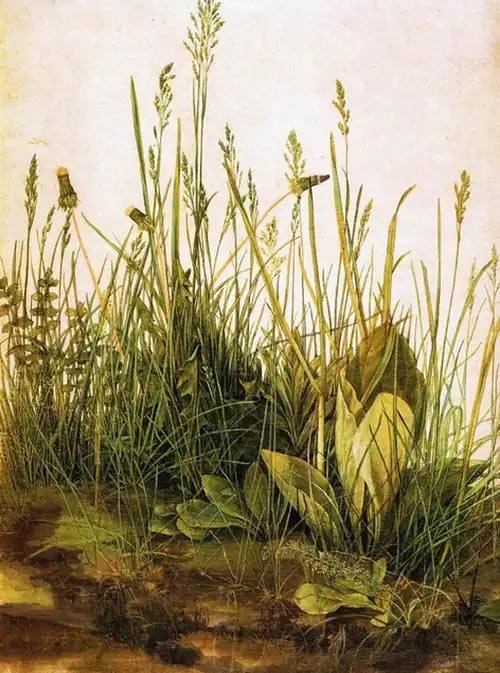 Albrecht Dürer, “Great Piece of Turf” (1503) Offering Back to the OneIn Tagore’s aesthetic vision, then, the artist transcends her individual self to inhabit the world in attentive love, and her art, nourished in ‘self-forgetful joy’, in turn sets forth the possibility of self-transcendence for others. In this way, Tagore affirms, a true work of art is ‘always speaking’, calling the recipient out of themselves towards the other. 'through her creative offerings, the artist responds to, realises and reflects, the divine, and, in this way, art approximates something akin to worship' The artist gazes on the world through the eyes of the heart, and through this intensive witnessing of reality, sees beyond the surface of things to inhabit, and to illumine, the silent fecundity of created being. Through her creative offerings, the artist responds to, realises and reflects, the divine, and, in this way, art approximates something akin to worship. The worshipper, like the artist, suspends her quotidian [usual, daily] self-orientation to give herself to the God who is perpetually giving Himself to the world. Elaborating this mode of self-offering, we repeatedly find across Tagore’s poetry the insistence that, through his creative efflorescence, he is only returning to God that which God has already gifted him. Just as the spring flowers blossom in God’s time and not ours, Tagore’s poems too have their ultimate root not in anything of his making but in the One who implants in all beings their particular perfections. This joyous cycle of gaining and giving is, for Tagore, the archetype of all our finite activities: to harmonise the tunes of our individual wills with the divine will, we must continually dedicate ourselves and our works to the divine singer, in whose breath we live, move, and have our being. On this note of the cosmic circuitry of receiving and returning, I will let the great C.S. Lewis, who echoes here the musical motifs of Tagore, have the last word: There is of course a sense in which no one can give to God anything which is not already His – and if it is already His, what have you given? But since it is only too obvious that we can withhold ourselves, our wills and hearts from God, we can, in that sense, also give them. What is His by right and would not exist for a moment if it ceased to be His (as the song is the singer’s), He has nevertheless made ours in such a way that we can freely offer it back to Him.
Marc Chagall biographer, Jackie Wullschlager: "The Nazis had begun their campaign against modernist art as soon as they seized power. Expressionist, cubist, abstract, and surrealist art—anything intellectual, Jewish, foreign, socialist-inspired, or difficult to understand—was targeted, from Picasso and Matisse going back to Cézanne and van Gogh; in its place traditional German realism, accessible and open to patriotic interpretation, was extolled." Will Durant, The Story Of Civilization: Speaking of ancient Egypt, "The greatest element of this civilization was its art. Here, almost at the threshold of history, we find an art powerful and mature, superior to that of any modern nation, and equaled only by that of Greece... The whole theory of progress hesitates before Egyptian art."
Norman Rockwell artwork
SEE MORE of Norman Rockwell artwork
The following is from Excursions to the Spirit World by Frederick C. Sculthorp. In 1934 the author suffered the untimely death of his wife. Grieving his loss, and after chancing upon the famous scientist Sir Oliver Lodge’s book “Why I Believe in Personal Immortality,” he decided to try his luck with a psychic-medium to contact his lost love. The results astonished him. He was given information that only she and he knew about. Moreover, this initial success led to something even more marvelous. Sculthorp discovered, with the psychic’s encouragement, that he too possessed abilities to access the coming dimensions. For the next decades, via “out-of-body” astral traveling during sleep, he would visit his wife in Summerland and, in the process, offered us much knowledge concerning life and society the next world: "My daughter, after passing over [to Summerland], told me that she had to use paints and brushes in the usual way when painting a picture, but later learnt to project the colours direct on to the canvas by thought."
Vincent van Gogh, "Old Man in Sorrow" (On the Threshold of Eternity), 1890
Ernest Becker: Victory "over human limitation is not something that can be programmed by science. […] it comes from the vital energies of masses of men sweating within the nightmare of creation. […] The most that any one of us can […] do is to fashion something - an object or ourselves - and drop it into the confusion, make an offering of it, so to speak, to the Life Force." Marc Chagall: “We all know that a good person can be a bad artist. But no one will ever be a genuine artist unless he is a great human being and thus also a good one.” Rainer Maria Rilke: “Go into yourself and test the deeps in which your life takes rise; at its source you will find the answer to the question whether you must create. Accept it, just as it sounds, without inquiring into it. Perhaps it will turn out that you are called to be an artist. Then take that destiny upon yourself and bear it, its burden and its greatness, without ever asking what reward might come from outside.”
Degas: Art is not what you see, but what you make others see. Boris Pasternak, Doctor Zhivago: "...he made a note reaffirming his belief that art always served beauty, and beauty is delight in form, and form is the key to organizing life, since no living thing can exist without it, so that every work of art, including tragedy, expresses the joy of existence." Paul Johnson: "...Hemingway's awareness of his inability to recapture his genius, let alone develop it, accelerated the spinning circle of depression and drink. He was a man killed by his art, and his life holds a lesson all intellectuals need to learn: that art is not enough."
Mark Twain: "We have not the reverent feeling for the rainbow that a savage has, because we know how it is made. We have lost as much as we gained by prying into that matter." Charles Kingsley: “There is something very wonderful in music. Words are wonderful enough; but music is even more wonderful. It speaks not to our thoughts as words do; it speaks straight to our hearts and spirits, to the very core and root of our souls. Music soothes us, stirs us up; it puts noble feelings in us; it melts us to tears; we know not how; -- it is a language by itself, just as perfect, in its way, as speech, as words; just as divine, just as blessed.” Francois Auguste Rodin: "I choose a block of marble and chop off whatever I don't need." Friedrich Nietzsche: "The struggle against a purpose in art is always a struggle against the moral tendency in art - against its subordination to morality. Art for art's sake means, Let morality go to the Devil."
Ron Merrill: "Any young person who has studied Heidegger; or seen Ionesco's 'plays'; or listened to the 'music' of John Cage; or looked at Andy Warhol's 'paintings'; has experienced that feeling of incredulous puzzlement: But this is nonsense! Can I really be expected to take this seriously? In fact, of course, it is necessary for it to be nonsense; if it made sense, it could be evaluated. The essence of modern intellectual snobbery is the 'emperor's new clothes' approach. Teachers, critics, our self-appointed intellectual elite, make it quite clear to us that if we cannot see the superlative nature of this 'art'- why, it merely shows our ignorance, our lack of sophistication and insight. Of course, they go beyond the storybook emperor's tailors, who dressed their victim in nothing and called it fine garments. The modern tailors dress the emperor in garbage." Ayn Rand: "The purpose of all art is the objectification of values." Ernest Becker, The Denial of Death: “Otto Rank asked why the artist so often avoids clinical neurosis when he is so much a candidate for it because of his vivid imagination, his openness to the finest and broadest aspects of experience, his isolation from the cultural world-view that satisfies everyone else. The answer is that he takes in the world, but instead of being oppressed by it he reworks it in his own personality and recreates it in the work of art. The neurotic is precisely the one who cannot create—the “artiste-manque,” as Rank so aptly called him. We might say that both the artist and the neurotic bite off more than they can chew, but the artist spews it back out again and chews it over in an objectified way, as an external, active, work project. The neurotic can’t marshal this creative response embodied in a specific work, and so he chokes on his introversions. The artist has similar large-scale introversions, but he uses them as material.”
Stars On A Pond, August Goforth
Eric Hoffer: "There is perhaps no better way of measuring the natural endowment of a soul than by its ability to transmute dissatisfaction into a creative impulse. The genuine artist is as much a dissatisfied person as the revolutionary, yet how diametrically opposed are the products each distills from his dissatisfaction." Pablo Picasso: "Often while reading a book one feels that the author would have preferred to paint rather than write; one can sense the pleasure he derives from describing a landscape or a person, as if he were painting what he is saying, because deep in his heart he would have preferred to use brushes and colors." Daniel Boorstin: "Artists and writers, I believe, have a special role, creating new questions for which they offer experimental answers. We are tested, enriched, and fulfilled by the varieties of experience. And as the years pass there are increasing advantages to being a questioner. Answers can trouble us by their inconsistency, but there is no such problem with questions. I am not obliged to hang on to earlier questions, and there can be no discord -- only growth -- between then and now. Learning, I have found, is a way of becoming inconsistent with my past self. I believe in vocation, a calling for reasons we do not understand to do whatever we discover we can do... I have observed that the world has suffered far less from ignorance than from pretensions to knowledge. It is not skeptics or explorers but fanatics and ideologues who menace decency and progress. No agnostic ever burned anyone at the stake or tortured a pagan, a heretic, or an unbeliever... If our knowledge is, as I believe, only an island in an infinite sea of ignorance, how can we in our short lifetime find satisfaction in exploring our little island? How can we persuade ourselves to be exhilarated by our meager knowledge and yet not be discouraged by the ocean vistas?..I am, then, a short-term pessimist but a long-term optimist. If our mission is an endless search, how can we fail? In the short run, institutions and professions and even language keep us in the discouraging ruts. But in the long run the ruts wear away and adventuring amateur reward us by a wonderful vagrancy into the unexpected." David Letterman: "Fall is my favorite season in Los Angeles, watching the birds change color and fall from the trees." Paul Dirac: "In science one tries to tell people, in such a way as to be understood by everyone, something that no one ever knew before. But in poetry, it's the exact opposite."
James Stephens: "Originality does not consist in saying what no one has ever said before, but in saying exactly what you think yourself." Jackson Pollock: "Every good painter paints what he is." James McNeill Whistler: "An artist is not paid for his labor but for his vision... As music is the poetry of sound, so is painting the poetry of sight and the subject-matter has nothing to do with harmony of sound or of color." Kandinsky: "There is no must in art because art is free." Giorgio DeChirico: "To become truly immortal, a work of art must escape all human limits: logic and commonsense will only interfere. But once these barriers are broken, it will enter the realms of childhood visions and dreams." Picasso: "Every child is an artist. The problem is how to remain an artist once he grows up." Howard Ikemoto: "When my daughter was about seven years old, she asked me one day what I did at work. I told her I worked at the college, that my job was to teach people how to draw. She stared back at me, incredulous, and said, 'You mean they forget?'" Francisco Goya: "Fantasy, abandoned by reason, produces impossible monsters; united with it, she is the mother of the arts and the origin of marvels." Michaelangelo: "The true work of art is but a shadow of the divine perfection."
Vincent Van Gogh: "It is not the language of painters but the language of nature which one should listen to; the feeling for the things themselves, for reality, is more important than the feeling for pictures." Henri de Toulouse Lautrec: "In our time there are many artists who do something because it is new; they see their value and their justification in this newness. They are deceiving themselves; novelty is seldom the essential. This has to do with one thing only; making a subject better from its intrinsic nature." John Adams, letter to Abigail Adams, May 12, 1780: "I must study politics and war that my sons may have liberty to study mathematics and philosophy. My sons ought to study mathematics and philosophy, geography, natural history, naval architecture, navigation, commerce and agriculture in order to give their children a right to study painting, poetry, music, architecture, statuary, tapestry, and porcelain." Louise Nevelson: "I think most artists create out of despair. The very nature of creation is not a performing glory on the outside, it's a painful, difficult search within." Abraham Moslow: "A musician must make music, an artist must paint, a poet must write if he is to be ultimately at peace with himself. What one can be, one must be." Emerson: "Classic art was the art of necessity: modern romantic art bears the stamp of caprice and chance." Martha Graham: "There is a vitality, a life force, a quickening that is translated through you into action, and because there is only one of you in all time, this expression is unique. If you block it, it will never exist through any other medium and be lost. The world will not have it. It is not your business to determine how good it is; nor how valuable it is; nor how it compares with other expressions. It is your business to keep it yours, clearly and directly, to keep the channel open. You do not have to believe in yourself or your work. You have to keep open and aware directly to the urges that motivate you. Keep the channel open. No artist is pleased. There is no satisfaction whatever at any time. There is only a queer, divine dissatisfaction; a blessed unrest that keeps us marching and makes us more alive than the others." Albert Einstein: "After a certain high level of technical skill is achieved, science and art tend to coalesce in esthetics, plasticity, and form. The greatest scientists are always artists as well." Albert Einstein: "I am enough of an artist to draw freely upon my imagination. Imagination is more important than knowledge. Knowledge is limited. Imagination encircles the world." Albert Einstein: "True art is characterized by an irresistible urge in the creative artist." John Ruskan, Emotional Clearing: "Artists can run into problems with their work... problems begin when the artist tries to establish a sense of social identity and acceptance through the art. The motivation shifts from pure self-expression to concern with whatever is being gained from the work... [resulting] in hampered creativity and eventual self-defeat." Eckhart Tolle: "All true artists, whether they know it or not, create from a place of no-mind, from inner stillness." Jean Cocteau: "Art is science made clear." Lawrence Durrell: "Music is only love looking for words." Albert Einstein: "It is the supreme art of the teacher to awaken joy in creative expression and knowledge." John F. Kennedy: "The life of the arts, far from being an interruption, a distraction in the life of a nation, is close to the center of a nation's purpose - and is a test of the quality of a nation's civilization."
|
|||||||||||||||||
|
|
